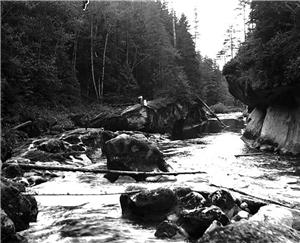On December 11, 1946, rising flood waters cause hundreds of families near Kent to leave their homes, and dairymen to move their herds from valley pastures to higher ground. The disaster renews discussions of a flood control dam needed high upstream on the Green River.
Until the 1960s, floods in the Green and White River valleys were common occurrences, almost always happening in the months of November or December. It is during this time of year that a warm Chinook wind from the north is likely to melt heavy snowfall in the mountains and also to cause heavy rain.
The 1946 flood was larger than most, causing the river to rise over its banks and to spread throughout the flat valley. Warnings were issued during the afternoon of December 11, but the river didn’t spill over until 8:00 p.m. Ranking officers of the state patrol, the army and navy, and the sheriff’s office rushed to Kent to prepare for evacuation.
Ducks to the Rescue
The army brought 13 amphibious trucks, known as “ducks,” a familiar emergency conveyance for valley residents. The Red Cross organized cots and blankets, and throughout the flood, the second floor of the Kent City Hall became a temporary home for more than 100 men, women, and children. Other families were taken in by neighbors who lived on higher ground.
A 24-hour-a-day canteen was set up in St. James Episcopal Church, and for the next five days, 3,000 meals were served to evacuees, soldiers, police officers, and local volunteers. Snacks were prepared around the clock.
Flood waters hit their peak Thursday morning, but it took weeks for the water to go down. For a time, downtown Kent was a lake. Some businesses were able to keep most of the water out with sandbags and pumps, but many suffered from damaged property and merchandise.
Back to the Dam Drawing Board
In the 1930s, the U.S. Army Corps of Engineers surveyed the flood problem of the valley, and intended to build a dam a few miles upstream from Auburn. This was opposed by fishing interests, due to the damage a dam would cause to spawning fish. The Army would have gone back to the drawing board, but World War II intervened.
Following the 1946 flood, the army engineers were brought back in for consultation. They recommended construction of a storage dam at Eagle Gorge, far to the east into the Cascade Mountains. Congress adopted the Eagle Gorge Dam as a federal project in 1950, and advanced planning continued throughout most of the decade.
The dam was formally dedicated as Howard A. Hanson Dam in 1962, named for Seattle attorney and state legislator Howard A. Hanson (d. 1957), who campaigned long and hard for the project. The dam brought an end to major flooding in the Green River Valley.

